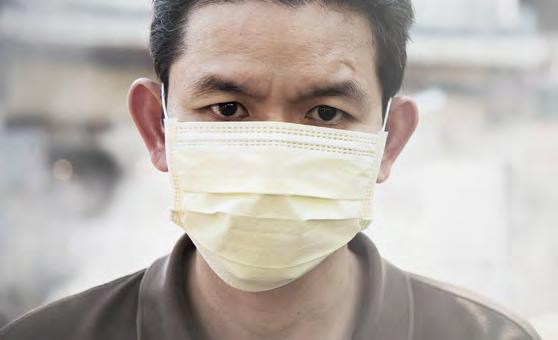
9 minute read
Best Shop Practices during the COVID-19 Pandemic
DURING THE COVID-19 PANDEMIC Best Shop Practice Recommendations
Editor’s Note: The following is an edited excerpt of a 15-page article by the Construction Industry Safety Coalition (CISC) titled “COVID-19 Exposure Prevention, Preparedness, and Response Plan for Construction.” The complete document is a “template” contractors can review and tailor to their own work and jobsites. The full document is available on the ISFA website’s COVID-19 Resource Page at www.isfanow.org/covid-19-resources.
Advertisement
The plan outlines steps every employer and employee can take to reduce risk of exposure
to COVID-19. It describes how to prevent worker exposure to coronavirus; protective measures to take on jobsites; personal protective equipment (PPE) and work practice controls to use; cleaning and disinfecting procedures; and what to do if a worker becomes sick.
This plan was based on information from the CDC and OSHA, and is subject to change based on further information provided by the CDC, OSHA and other public officials.
All managers and supervisors should be familiar with this or a similar plan and be ready to answer questions from employees. Managers and supervisors should set a good example by following it at all times. This involves practicing good personal hygiene and jobsite safety practices to prevent the spread of the virus. Managers and supervisors should encourage this same behavior from all employees.
In order to minimize the spread of COVID-19 at jobsites, everyone must participate while at work. Companies should institute various housekeeping, social distancing and other best practices at jobsites that employees must follow. In addition, employees are expected to report to their managers or supervisors if they are experiencing signs or symptoms of COVID-19. Questions about the plan should be directed to a manager or supervisor.
OSHA and the CDC have provided control and preventative guidance to all workers, regardless of exposure risks that are examined in greater detail in the full CISC document. The full document also provides a checklist for employers and employees.
COVID-19 Checklist for Employers and Employees
Know the Symptoms of COVID-19:
aches, sore throat, headache, diarrhea, nausea/ vomiting and runny nose. If you develop a fever and symptoms of respiratory illness, DO NOT GO TO WORK and call your healthcare provider immediately. Do the same thing if you come into close contact with someone showing these symptoms.
Employer Responsibilities:
■ Develop a COVID-19 Exposur e Action Plan.
■ Conduct safety meetings (toolbox talks) by phone if possible. If not, instruct employees to maintain 6 ft. between each other. The foreman/ supervisor should track attendance verbally rather than having employees sign an attendance sheet.
■ Access to the jobsite and work trailer should be limited to only those necessary for the work.
■ All visitors should be prescreened to ensure they are not exhibiting symptoms.
■ Employees, contractors and visitors should be asked to leave the jobsite and r eturn home if they are showing symptoms.
■ Provide hand sanitizer and maintain Safety Data Sheets of all disinfectants used on site.
■ Pr ovide personal protective equipment to any employees assigned cleaning/disinfecting tasks.
■ Talk with business partners about your response plans. Share best practices with other businesses in your communities (especially those in your supply chain), chambers of commerce and associations to improve community response efforts.
Employee Responsibilities:
■ Become familiar with the Exposure Action Plan and follow all elements of the plan.
■ Practice good hygiene. Wash hands with soap and water for at least 20 seconds. If these are not available, use alcohol-based hand sanitizer with at least 60 percent alcohol. Avoid touching your face, eyes, food, etc. with unwashed hands.
Cleaning/Disinfecting Jobsites and Other Protective Measures
■ Clean and disinfect frequently used tools and equipment on a regular basis, as well as other elements of the jobsite where possible.
■ Clean shar ed spaces such as trailers and break/lunchrooms at least once per day. ■ Disinfect shar ed surfaces (door handles, machinery controls, etc.) on a regular basis.
■ A void sharing tools with co-workers. If not possible, disinfect before and after each use.
■ Arrange for any portable jobsite toilets to be cleaned by the leasing company at least twice per week and disinfected on the inside.
■ Trash containers with trash from the jobsite must be emptied frequently by someone wearing gloves.
Protective Equipment and Alternate Work Practice Controls
■ Pr ovide and wear the proper PPE. ■ Keep dust down by using engineering and work practice contr ols, specifically through the use of water delivery and dust collection systems.
OSHA and the CDC have provided control and preventative guidance to all workers as to prevention and work practice controls that are examined in greater detail in the full CISC document. The full document also provides a condensed list.
COVID-19 Prevention and Work Practice Controls
Worker Responsibilities:
■ Always wash hands that are visibly soiled. ■ Cover your mouth and nose with a tissue when you cough or sneeze or use the inside of your elbow. ■ Avoid touching your eyes, nose or mouth with unwashed hands.
■ Avoid close contact with people who are sick.
■ Employees who have symptoms (i.e., fever, cough or shortness of breath) should notify their supervisor and stay home — DO NOT GO TO WORK. ■ Sick employees should follow CDCrecommended steps. Employees should not return to work until the criteria to discontinue
■ Clean AND disinfect frequently touched objects and surfaces such as workstations, keyboards, telephones, handrails and doorknobs. Dirty surfaces can be cleaned with soap and water prior to disinfection. To disinfect, use products that meet Environmental Protection Agency’s (EPA) criteria for use against SARS-CoV-2external icon, the cause of COVID-19, and are appropriate for the surface. ■ Avoid using other employees’ phones, desks, offices or other work tools and equipment, when possible. If necessary, clean and disinfect them before and after use.
■ Clean and disinfect fr equently used tools and equipment on a regular basis as well as other elements of the office where possible. Employees should regularly do the same in their assigned work areas.
■ Clean shar ed spaces such as break/lunchrooms at least once per day. ■ Disinfect shar ed surfaces (door handles, machinery controls, etc.) on a regular basis.
Jobsite Exposure Situations
If an employee exhibits COVID-19 symptoms, the employee must remain at home until he or she is symptom free for 72 hours (three full days) without the use of fever-reducing or other symptom-altering medicines (e.g., cough suppressants). The company should similarly require an employee that reports to work with symptoms to return home until they are symptom free for 72 hours. To the extent practical, employees are required to obtain a doctor’s note clearing them to return to work.
An employee that tests positive for COVID-19 should be directed to selfquarantine away from work. Employees that test positive and are symptom free may return to work when at least seven days have passed since the date of his or her first positive test, and have not had a subsequent illness. Employees that test positive and are directed to care for themselves at home may return to work when at least 72 hours have passed since recovery AND at least seven days have passed since symptoms first appeared. Employees that test positive and have been hospitalized may return to work when directed to do so by their medical care provider. The company should require an employee to provide documentation clearing their return to work.
Individual employees that have come into close contact with a confirmedpositive COVID-19 individual (co-worker or otherwise) should be directed to self-quarantine for 14 days from the last date of close contact with the carrier. Close contact is defined as 6 ft. for a prolonged period of time. If the company learns that an employee has tested positive, the company will conduct an investigation into co-workers that may have had close contact with the confirmed-positive employee in the prior 14 days and direct those individuals to self-quarantine for 14 days from the last date of close contact with the carrier. If an employee learns that he or she has come into close contact with a confirmed-positive individual outside of the workplace, he/ she must alert a manager or supervisor of the close contact and also selfquarantine for 14 days from the last date of close contact with the carrier.
OSHA Recordkeeping
If a confirmed case of COVID-19 is reported, the company should determine if it meets the criteria for recordability and reportability under OSHA’s recordkeeping rule. OSHA requires construction employers to record workrelated injuries and illnesses that meet certain severity criteria on the OSHA 300 Log, as well as complete the OSHA Form 301 (or equivalent) upon
the occurrence of these injuries. For purposes of COVID-19, OSHA also requires employers to report to OSHA any work-related illness that results in a fatality or in the hospitalization (formal admission to the in-patient service of a hospital or clinic) of one or more employee. OSHA has determined that COVID-19, unlike the common cold or the seasonal flu, is an “illness.” However, OSHA has stated that only confirmed cases of COVID-19 should be considered an illness under the rule. Thus, if an employee simply comes to work with symptoms consistent with COVID-19 (but not a confirmed diagnosis), the recordability analysis would not necessarily be triggered at that time.
If an employee has a confirmed case of COVID-19, the company must conduct an assessment of any workplace exposures to determine if the case is work-related. Workrelatedness is presumed for illnesses that result from events or exposures in the work environment, unless it meets certain exceptions. One of those exceptions is that the illness involves signs or symptoms that surface at work but result solely from a non-work-related event or exposure that occurs outside of the work environment. Thus, if an employee develops COVID-19 solely from an exposure outside of the work environment, it would not be work-related, and thus not recordable. The company’s assessment must consider the work environment itself; the type of work performed; risk of person-toperson transmission given the work environment; and other factors such as community spread. Further, if an employee has a confirmed case of COVID-19 that is considered work-related, the company must report the case to OSHA if it results in a fatality within 30 days or an in-patient hospitalization within 24 hours of the exposure incident occurring.
‘Essential’ Industry
Some states and localities issued orders that prohibit work and travel, except for essential businesses. In general, construction work has been deemed essential. If upon travel to and from the worksite, an employee is stopped by authorities, employees should be provided a letter indicating they are employed in an “essential” industry and are commuting to and from work.
Confidentiality/Privacy
Except for circumstances in which the company is legally required to report workplace occurrences of communicable disease, the confidentiality of all medical conditions should be maintained in accordance with applicable law and to the extent practical under the circumstances. When required, the number of persons informed of an employee’s condition will be kept at the minimum needed not only to comply with legally required reporting, but also to assure proper care of the employee and to detect situations where the potential for transmission may increase. A notice to employees should be issued, and the company should reserve the right to inform other employees that a co-worker (without disclosing the person’s name) has been diagnosed with COVID-19. This is so co-workers that might have been exposed may take measures to protect their own health.
About the Author
The Construction Industry Safety Coalition comprises 27 trade associations, representing all sectors of the construction industry, including commercial building, heavy industrial production, home building, road repair, specialty trade contractors and material suppliers. Workplace health/safety is a priority for all members, and each is committed to helping create safer jobsites for workers. For more information visit www. buildingsafely.org.










